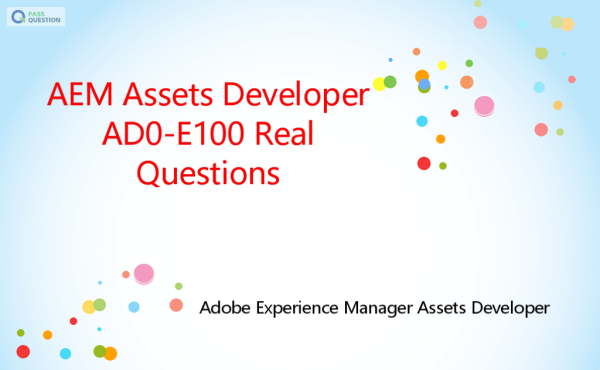AEM Assets Developer AD0-E100 Real Questions - Adobe Experience Manager Assets Developer
Want to pass AD0-E100 Adobe Experience Manager Assets Developer exam? PassQuesiton provides potential candidates with AEM Assets Developer AD0-E100 Real Questions they need to prepare for the certification exam.With the learning information and guidance of PassQuestion AD0-E100 questions and answers, you can through Adobe Experience Manager Assets Developer AD0-E100 exam successfully in your first time.

AEM Assets Developer AD0-E100 Exam Information
Exam number: AD0-E100
Exam name: Adobe Experience Manager 6 Assets Developer
Certificate level: Certified Expert
Available languages: English
Number of questions: 50
Formats: Multiple choice and multiple select
Duration: 65 minutes
Delivery: Online proctored (requires camera access) or test center proctored
Passing mark: 72% or 550 using a scaled score format of 300 to 700
Price: $180 USD
Minimum Candidate Experience
AD0-E100 Adobe Experience Manager Assets Developer exam is designed for individuals who are currently performing or have previous work experience with the job responsibilities of an Adobe Experience Manager Developer.
At a minimum, the candidate seeking to become certified as an Adobe Experience Manager Assets Developer has:
1+ years CMS experience
1+ years CQ 5.x/AEM 6.x experience
1+ years Java developer experience
Understands taxonomies and AEM tagging, AEM workflows, JCR, Sling, OSGi and databases
Adobe Experience Manager Assets Developer AD0-E100 Exam Sections
Section 1: Workflows (22%)
You should be able interpret client needs in order to recommend the appropriate workflow strategies.
You should know how to create custom asset workflows and custom workflow steps, modify existing asset workflows, and integrate workflows with InDesign Server.
Section 2: Metadata (32%)
You should be able to generate renditions of different sizes and types, and make decisions required to customize metadata schema for different asset types.
You should be able to evaluate a taxonomy hierarchy based on a client’s use case, enable assets to be easily searchable, and configure assets for translation.
Section 3: OSGi Bundles (28%)
You should be able to make decisions required to develop OSGi bundles to manipulate assets.
View Online AEM Assets Developer AD0-E100 Free Questions
1.An author uploads a PDF document and receives a “Restricted Files” error.
What is causing this problem?
A. The file extension is not registered as an allowed asset MIMES in the OSGI config, Day CQ DAM Asset Upload Restriction.
B. The file extension is case-sensitive and should be all lower case.
C. The user does not have permission to upload an asset with the specific file extension.
D. The MIME Type mapping setup for the file extension does not exist in OSGI config, Day CQ Scene7 Asset Mime type Service.
Answer: A
2.A company requires importing more than 1000 images at once regularly. During the import process, the Author instance becomes very slow or unresponsive.
What should a developer do to avoid this result?
A. Reduce the number of renditions generated for images.
B. Increase the memory and use a multi-core CPU for the instance.
C. Set up a dedicated processing instance for asset ingestion.
D. Limit the concurrent authors allowed on the author instance.
Answer: B
3.A company uploaded several images that represent products, and each product is associated with a unique SKU number. The product owner would like the ability to search for multiple products by SKU number.
What two steps must be completed to do this? (Choose two.)
A. Customize the Assets Admin Search rail to include a Single Property Predicate and configure the property name to the SKU number
B. Customize the image metadata schema and add a new Multi Value Text field for the SKU number
C. Customize the Assets Admin Search rail to include a Multi Value Property Predicate and configure the property name to the SKU number
D. Customize the image metadata schema and add a new Single Line Text field for the SKU number
Answer: BC
4.A developer writes the following code to programmatically copy an existing asset to another folder in the DAM:

After executing this code, the developer receives the following exception: javax.jcr.PathNotFoundException
What caused this issue?
A. The user lacks CREATE permission to the path /content/dam/projectB
B. The path /content/dam/projectB does not exist
C. The user lacks READ permission to the asset in /content/dam/projectA
D. The asset in /content/dam/projectA/asset.jpg does not exist
Answer: D
5.A developer modified the default image metadata schema to include a text field with the property 'myProject:photographer'. While testing, the developer edited the metadata of an asset and entered the name 'Sebastião Salgado' onto the custom field.
However, the developer encountered an issue and noticed that the value of the custom field is not displaying on a component.
What is a possible cause of this issue?
A. The namespace 'myProject' isn't registered.
B. The text field does NOT accept special characters.
C. The property name 'myProject:photographer' is too long.
D. The property 'myProject:photographer' already exists and is causing conflicts.
Answer: B
6.A company has a set of DAM assets related to “hiking”. Most of the assets have the keyword “hiking” in title and/or description in the metadata, and they are showing up in omnisearch while searching for “hiking”. Another set of mountain assets are later added to the DAM without the “hiking” keyword in their metadata.
What changes can be done to include the mountain assets in the top of the result while searching for “hiking”?
A. In asset metadata editor, create and assign the “hiking” tag to all mountain assets.
B. In asset metadata editor, add the keyword “hiking” in search boosting to all mountain assets.
C. Add the keyword “hiking” to the Content and Status of the mountain assets in metadata.
D. Ensure the mountain assets are placed before the hiking assets in a folder named “hiking”.
Answer: A
- TOP 50 Exam Questions
-
Exam
All copyrights reserved 2025 PassQuestion NETWORK CO.,LIMITED. All Rights Reserved.

